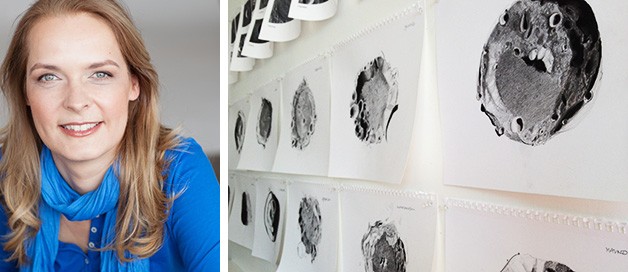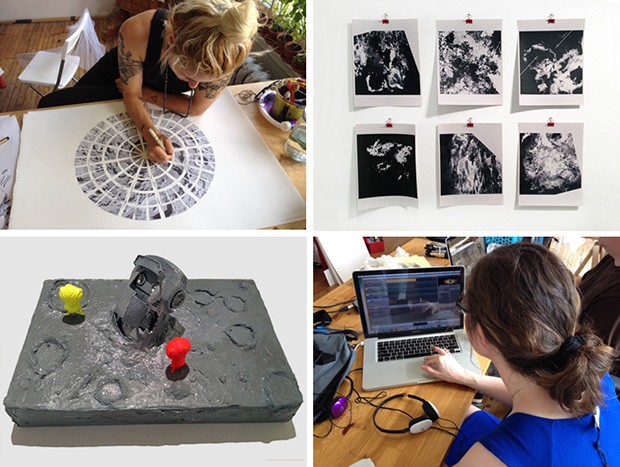Where astronomy, education and art meet
 “Projects that allow for a mix of traditional art media and new technologies such as 3D printing are fascinating to me,” says Bettina Forget. At right: moon crater sketches. | All images courtesy of the artist
“Projects that allow for a mix of traditional art media and new technologies such as 3D printing are fascinating to me,” says Bettina Forget. At right: moon crater sketches. | All images courtesy of the artist
On Saturday, February 6, Concordia’s Art Education Graduate Student Association is hosting Inquire and Inspire, a symposium that provides the students with a chance to share their latest research and artistic practices.
Bettina Forget, an MA in Art Education student and owner of the Visual Voice Gallery in Montreal, is the keynote speaker. We spoke with Forget, about her extensive work as a visual artist, cultural curator and self-described “astro- nerd.”
What are you working on right now?
Right now I'm focusing on balancing my graduate work with running my gallery and keeping up my artistic practice. Thankfully all three areas of activity overlap and reinforce each other. The grand theme of my research in teaching, curating and art making is the intersection of art and science.
My gallery — Visual Voice Gallery — exhibits art that is in dialogue with science. Currently, I'm organizing the 2016-17 programming, which is much like creating an artwork. The gallery is the empty canvas, and I'm filling it with artworks, workshops, artists’ talks and podcasts. The program is shaping up nicely. I love working with artists, they are so invested and passionate about what they do.
Visual Voice Gallery also presents workshops that dovetail with its programming. In my graduate research here at Concordia I'm especially interested in creating things that are prompt based and open, in the vein of the Makerspace movement. Projects that allow for a mix of traditional art media and new technologies such as 3D printing are fascinating to me; this is such a vibrant, nascent space to work in.
Finally, I circle off some time in my agenda to pursue my own artistic practice. Currently, I'm working on a project that explores Moon craters. I just finished a series of drawings of Moon craters named after women. Guess how many there are? Twenty seven. Out of 1,605 named craters. So, you could say that women are somewhat underrepresented. Now I'm working on getting LIDAR data from NASA's LCROSS satellite into a format that can produce STL files for 3D printing. I would love to hold a moon crater in my hand.
 The Moon Mission workshop at Visual Voice.
The Moon Mission workshop at Visual Voice.
What are new trends and directions in your area of research or creation?
STEAM education (interdisciplinary studies in the areas of science, technology, engineering, arts and mathematics) and the Maker movement (learning by doing) are emerging currents in education. Most literature discussing Maker education foregrounds the engineering side of the movement, but I would like to explore how art education can benefit from the Maker ethos.
How do ideas translate between the disciplines of science, technology, engineering, art and math? What happens in that loop of ideation, making, reflection and iteration? And what role can art play in STEAM and Maker education other than providing engineering projects with a nice design?
This fusion of art and science is also emerging in the world of contemporary art. BioArt, earth art, astronomical art and art informed and inspired by all the hard sciences are on the rise, especially in Europe. I notice that artists are becoming increasingly interested in collaborations with scientists and serious research/creation, rather than just borrowing scientific aesthetics.
This new interest in SciArt is also reflected in the increase of artist-in-residence programs offered by scientific research institutions such as the SETI Institute and CERN, and art schools that offer SciArt courses, such as Central Saint Martins in London and the School of Visual Arts in New York.
What communities do you feel most connected to or engaged by?
Montreal has a fantastic arts community, and this is where I feel most at home. I've been running Visual Voice Gallery for over eight years, so I've had the opportunity to meet many incredibly talented and driven artists and curators. My gallery is in the Belgo building, my home away from home. The Belgo houses 25 galleries, plus a few dance studios, architects’ offices and yoga studios.
To promote this little community of creative souls I launched The Belgo Report, an online art-review magazine, in 2007. The Belgo Report reviews art exhibitions taking place in the galleries of the Belgo. It's entirely volunteer run by a great team of writers who contribute articles. I used to write for the Report, but due to time constraints I have now limited my role to producer and editor.
I support the artistic community through my work with the English Language Arts Network (ELAN), where I currently serve as president. ELAN does amazing work promoting and advocating for the English-language artistic community in Quebec. From organizing tours and workshops, to voicing the concerns of the artistic community, the ELAN team gets things done! They are a wonderful organization to work with.
I also have one foot in the world of astronomy. As an avid astro-nerd (I own three telescopes), I still like to get out with my eight-inch Dobsonian and sketch at the eyepiece. I was a member of the Royal Astronomical Society of Canada (RASC) for years and even did a stint as president of the RASC Montreal Centre. Amateur astronomers are just as passionate as artists. The subject may be different, but the enthusiasm is the same.
What are some of your recent accomplishments?
I am delighted to have been offered the position of art/science researcher at the SETI Institute's artist-in-residence (AIR) program. I'm going to spend three months in the San Francisco Bay area this summer, interviewing the scientists and artists involved in the AIR program, and also helping to set up the SETI AIR archive.
This research will form part of the data collection portion for my MA in Art Education thesis. The SETI AIR artists are an impressive group, and I can't wait to get them in front of the microphone. And I'll get my own access key to the Carl Sagan Centre. A dream come true!
Hear Bettina Forget speak at the art education graduate student symposium, Inquire and Inspire, taking place on Saturday, February 6, from 9 a.m. to 5:30 p.m., in Room FB-620 of the Faubourg Building (1250 Guy St.), on the Sir George Williams Campus.
The event is free and open to the public.